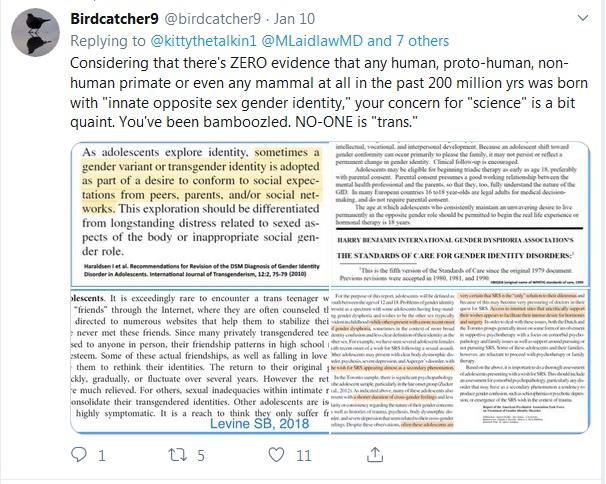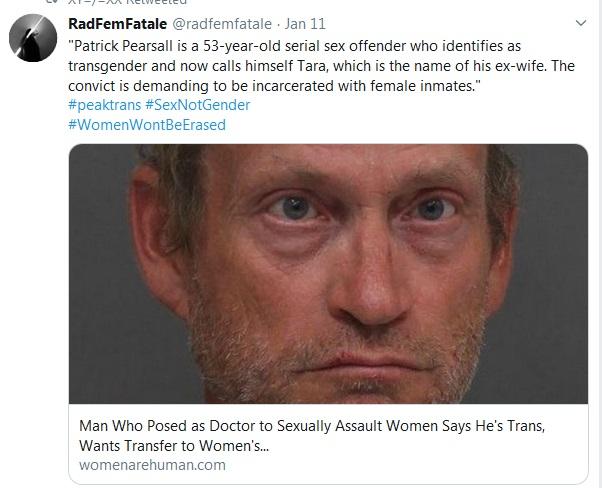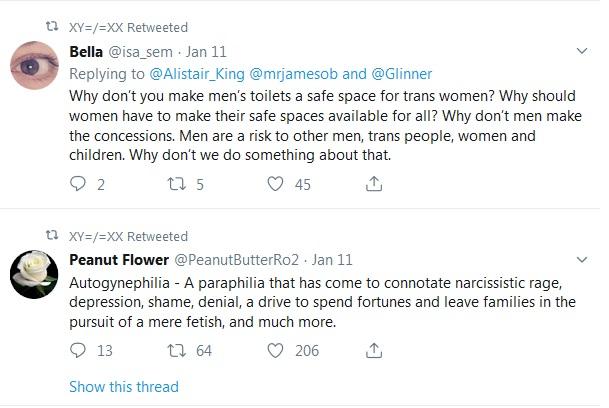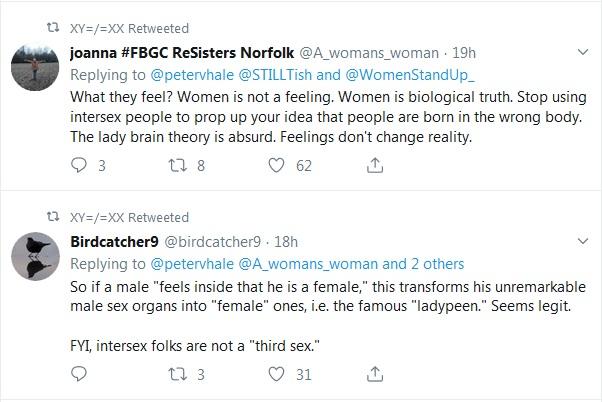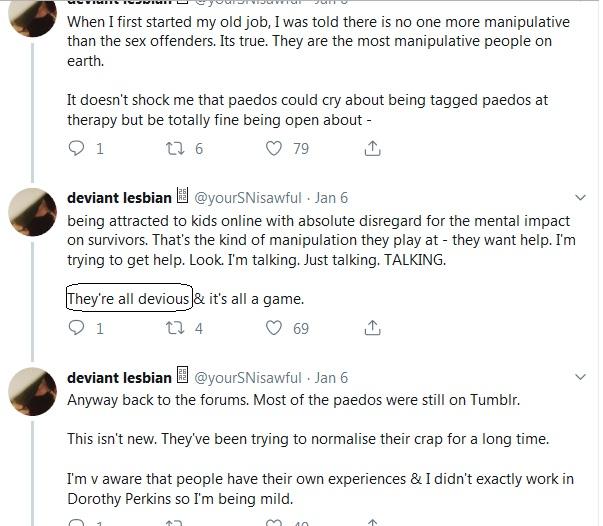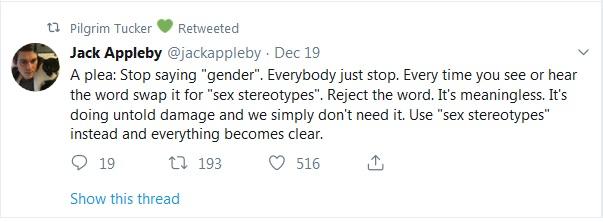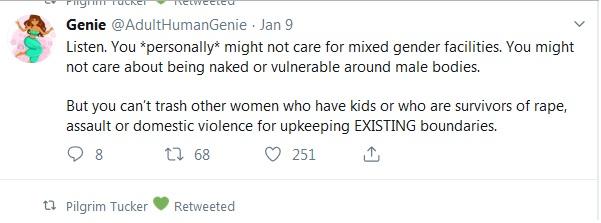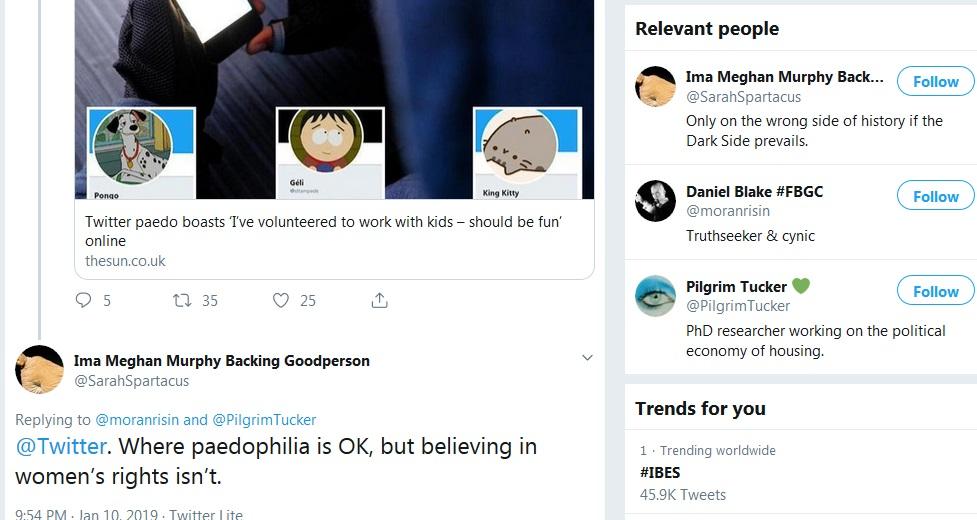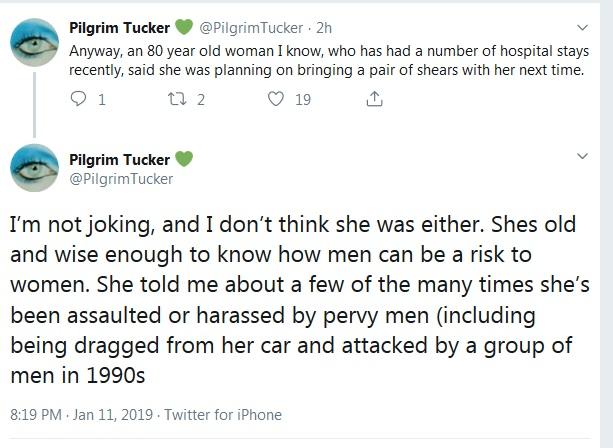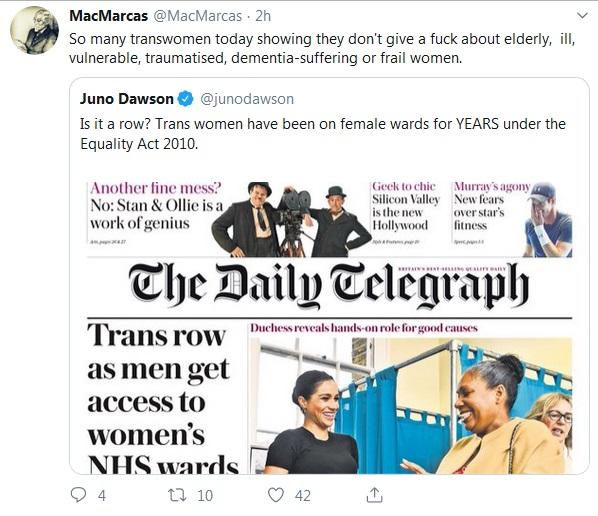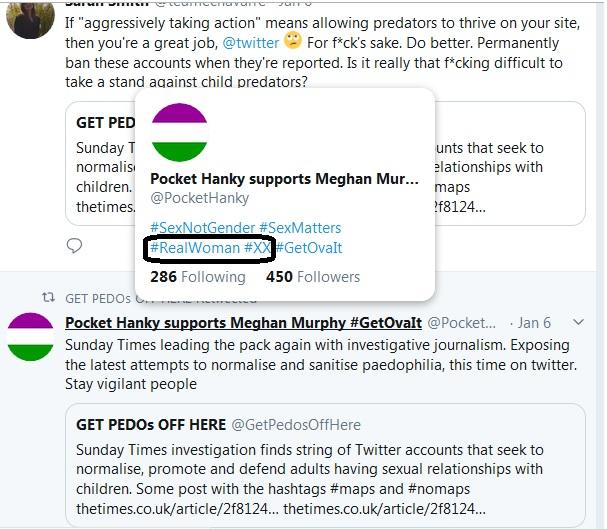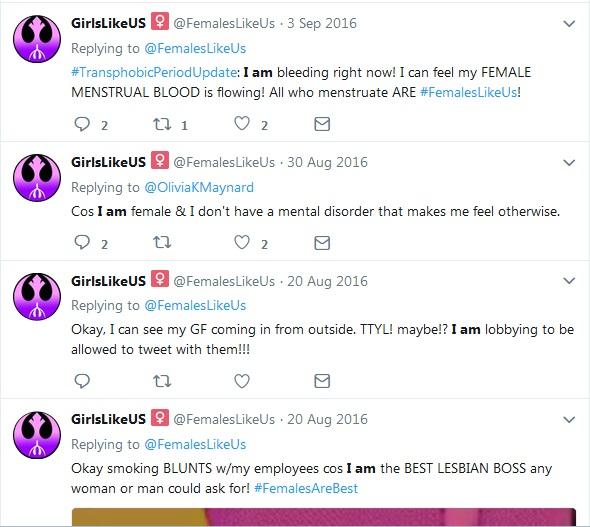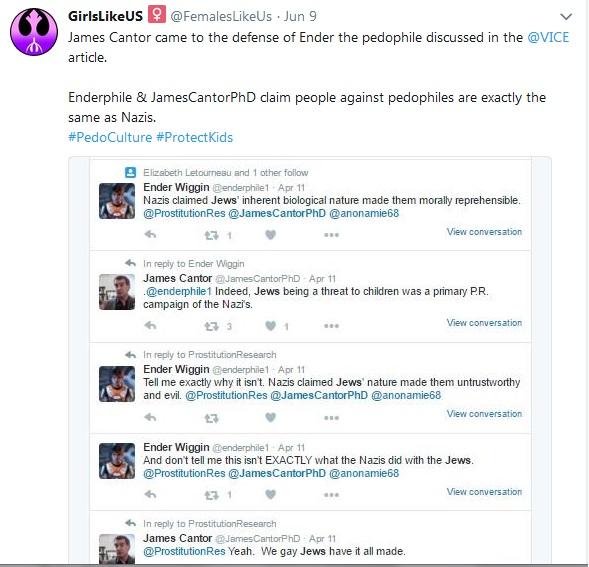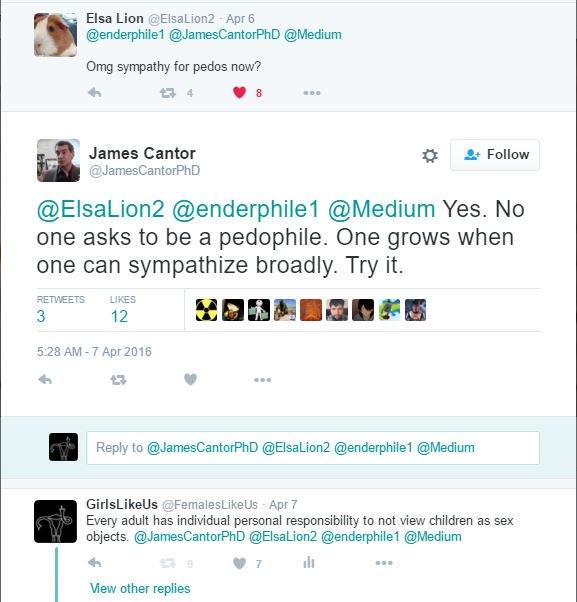The Y-ellow Streak
Radical-Feminists and their War with Twitter, Transgenders, Pedophiles, and Risk
By Bernie Najarian
Jan. 18, 2019
Historically, some people have believed that broadly defined groups of other people could be intrinsically tainted by nature.
In 1926, the very popular author W. Somerset Maugham outraged the British colonizers of Malaysia by publishing some short stories about them that cut a little too close. One of the stories was titled ‘The Yellow Streak.’ It was about how “a drop of native blood,” as Maugham’s character put it, was thought to be able to subtly pervert your spirit.
[quote]
“… The whisky Izzart had drunk made him feel very wide awake, and he was not inclined to go to bed. He took off his ducks, put on a sarong and lit a cheroot. His good-humour was gone. It was the sight of Hutchinson looking fondly at the half-caste child which had upset him.
'They've got no right to have them,' he said to himself 'They've got no chance in the world. Ever.'
… He wondered whether by any chance the men at Kuala Solor with whom he was so hail-fellow-well-met suspected that he had native blood in him. He knew very well what to expect if they ever found out. They wouldn't say he was gay and friendly then, they would say he was damned familiar; and they would say he was inefficient and careless, as the half-castes were, and when he talked of marrying a white woman they would snigger. Oh, it was so unfair! What difference could it make, that drop of native blood in his veins, and yet because of it they would always be on the watch for the expected failure at the critical moment. Everyone knew that you couldn't rely on Eurasians, sooner or later they would let you down; he knew it too, but now he asked himself whether they didn't fail because failure was expected of them. They were never given a chance, poor devils.
(Later, in a near-drowning incident in a boat overturned by a massive tidal bore, Izzart feels he acted in a cowardly way by striking for shore without trying to save his colleague Campion. Though Campion feels similar guilt and later protects him, Izzart can’t resist polishing his reputation by making Campion’s own decisions seem wrong – BN.)
There was a pause, and Campion looked for a while reflectively at Izzart. 'There's only one thing I'd like to ask you: I've made a good many friends here, and there are one or two things I'm a little sensitive about; when you tell the story of our upset, I should be grateful if you wouldn't make out that I had behaved badly. I wouldn't like the fellows here to think that I'd lost my nerve.'
Izzart flushed darkly. He remembered what he had said to the Resident (the colonial administrator – BN). It almost looked as though Campion had been listening over his shoulder. He cleared his throat.
'I don't know why you think I should do that.'
Campion chuckled good-naturedly, and his blue eyes were gay with amusement.
'The yellow streak,' he replied, and then, with a grin that showed his broken and discoloured teeth: 'Have a cheroot, dear boy.'”
[end quote]
As 2018 crossed over to 2019, the sallow unreliability of self-described non-offending pedophiles (NOMAPs = ‘non-offending minor-attracted persons’) became a major issue among one of the prominent feminist subgroups campaigning on Twitter. This was not because of any recent or historic crime committed by someone who might have self-described as a NOMAP. It was more about what was doomed to happen if such people became admissible in discourse, i.e., ‘normalized.’
And, most prominently, it was about how the powerful Twitter social media network was allowing this predicted outrage to happen.
There was more to this campaign, however, than met the eye. As you can see in this article’s title, it wasn’t just about pedophiles by any means.
Leading the charge on Jan. 6, 2019, was reporter Rosamund Urwin from the Sunday Times (UK), in her story called “Revealed: flood of Twitter users back paedophilia.” Like nearly all participants in the nervously conformist business of writing for the mainstream press, she fudged the two popular meanings of the word ‘paedophilia’ together – the sexual action and the orientational state – to make all paedophiles seem sexually active, NOMAPs notwithstanding. In fact, she read especial scandal into tweets that assured readers that NOMAPs were resolute in their commitment not to commit sexual assaults.
“While this (actively pro-pedosex – BN) user’s account is now blocked,” she wrote, “there are still others defending paedophiles on the site. One user posted: “People, there is zero (0, zilch, zip) evidence that a paedophile who hasn’t abused a child will ‘succumb to their urges’ and offend someday. It’s COMPLETELY a myth.” Another, who claims to be a supporter of the MAPs community, wrote: “‘(Saying) you’re a #pedophile (and) I don’t trust you around kids’ is the equivalent of saying ‘You’re a straight male. I don’t trust you around females.’”
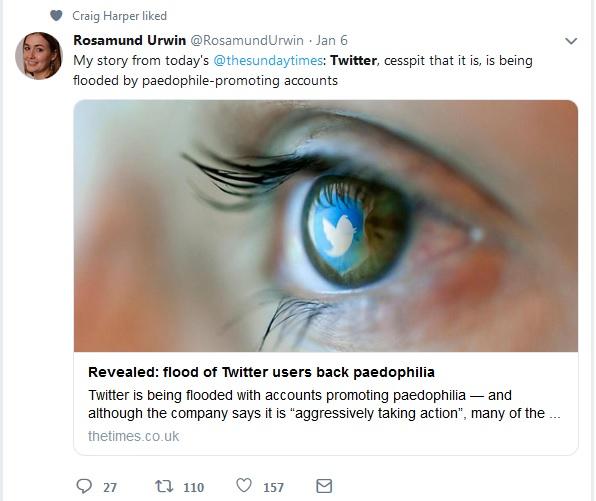
No doubt, to find these slightly complacent-sounding non-offender statements, she read through dozens more stating in various other ways that the NOMAP tweeters rejected and detested sexual abuse of children.
Urwin juxtaposed her chosen NOMAP statements with those of Damian Collins, chairman of the UK House of Commons digital, culture, media and sport committee, who harrumphed: “Twitter must commit the resources to make sure that vile material is taken down, or this will become another example of the failure of big social media companies to act against harmful and disgusting content.” He called for legislative action to outlaw such material.
This would surely be the first time a law was ever made to ban people who were engaged in assuring readers they were committed to obeying the law.
The reason these commitments could be overlooked was, of course, the yellow streak. In any minority held in social opprobrium, statements of good will or social responsibility are never to be believed.
Urwin’s article also notably confused two distinct recent online phenomena. One was the establishment of floridly provocative fake pro-sex pedophile accounts by 4chan and (probably) Russian trolls from early 2017 onwards, a social destabilization campaign that has been debunked multiple times by the present writer (https://justpaste.it/15vex, https://justpaste.it/7gtqd), Snopes.com (https://www.snopes.com/fact-check/maps-pride-flag/, https://www.snopes.com/fact-check/lgbtp-adding-letter/) and others (https://www.nbcnews.com/tech/tech-news/posing-gay-men-twitter-troll-goes-viral-attempts-falsely-tie-n954721, https://www.them.us/story/behind-the-weird-internet-scheme-to-associate-pedophiles-with-the-lgbtq-community). The other was a recent influx of NOMAPs, as well as a few pro-sex pedophiles, ambiguous accounts, and 'pedo-hunter' accounts mimicking pedophile accounts, from the recently revamped tumblr.com website, which expelled both pedophilia-discussing and erotic content in 2018. Urwin’s article implied that the incoming tumblr NOMAPs were part of a 4chan troll campaign to promote pedosex.
[quote]
A Sunday Times investigation has found a string of accounts on Twitter that seek to normalise, promote and defend adults having sexual relationships with children. Some post with the hashtags #maps and #nomaps. “Maps” stands for “minor attracted person”, while “Nomaps” stands for “non-offending minor attracted person” and is used by those who claim they do not act on their attraction to children. It is believed that the deluge of anonymous pro-paedophilia accounts on Twitter was orchestrated by users of the controversial message board 4chan. Twitter said: “This type of deliberate attempt to undermine and disrupt the health of the public conversation has absolutely no place on our service.”
[end quote]
Urwin’s fusion of the sincere NOMAPs and the fake-news 4chan trolls was all the more remarkable in that just two days earlier, on Jan 4, Ben Collins of NBC News had done a meticulous dissection of some fake-pedophile troll activity that had recently been publicized as typical liberalism by gleefully outraged pro-Trump tweeters (https://www.nbcnews.com/tech/tech-news/posing-gay-men-twitter-troll-goes-viral-attempts-falsely-tie-n954721). Collins’ piece was completely free of confusion between this trolling and the NOMAP tweeters, who were among the prominent opponents of the troll accounts.
I realized that there had to be an explanation, perhaps not frankly disclosed, for the heavily slanted nature of Urwin’s write-up, which temporarily turned the august Sunday Times into a purveyor of tabloid shock-trash. It didn’t take long to find the real villain in Urwin’s weltschmerz: Twitter.
Urwin was very unhappy with Twitter, in part, because its randomly robotic problem-report system had failed to help her with a pernicious schizophrenic stalker who had been using the website to creep her out (https://www.thetimes.co.uk/article/stalking-ordeal-it-feels-like-my-tormentors-rights-trump-mine-j3f9bm0dg, Aug. 12, 2018). The website also declined, in keeping with its privacy policies, to help her make a readout of the harassing tweets in order to show them to police, and she was told that a direct police request to Twitter would be necessary. The Times’ editors had rushed to her aid, as well as that of other victims of stalkers, by sponsoring a campaign under her leadership.
[quote]
Today Rosamund Urwin, this newspaper’s financial services correspondent, launches our Stop Stalking campaign with an account of her own unsettling harassment. “At every step,” she says, “it has felt like my stalker’s rights trump mine.” Now the Conservative MP Sarah Wollaston is urging the government to back her private member’s bill, which will introduce protection orders and restrict an offender’s access to sites such as Twitter and Facebook.
[end quote]
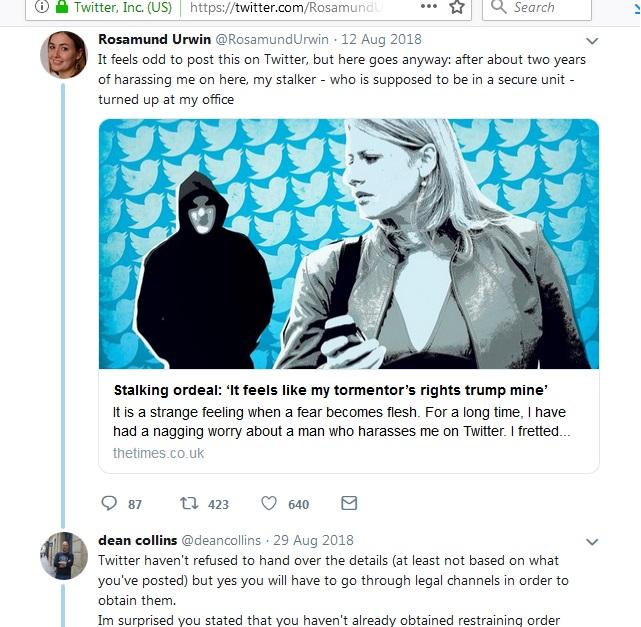
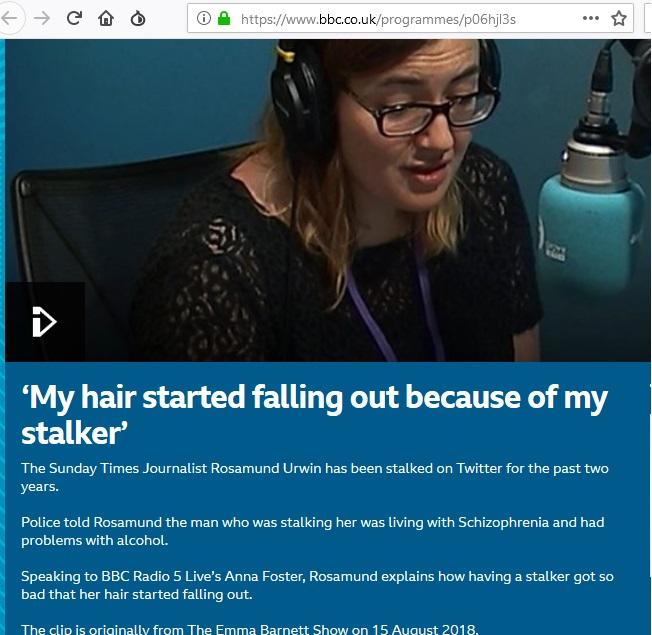
After August, Urwin’s tweets had frequently commented on what a bunch of rotters the administrators of Twitter were.
On 6 Oct. 2018, she took an interest in Twitter’s treatment of a woman called Jessica Eaton (@Jessicae13Eaton), who Twitter had temporarily locked out of her account because she had told her own stalker, @JoeDirrtt, “I cannot imagine being as dark as you and going on the internet to do this type of stuff to people you never met. I wonder what you would say to my face. Coward.” Twitter, which has fed its algorithmic robots a list of derogatory words to react to as breaches of its abuse policies, apparently automatically reacted to the word “coward.”
The stalker’s prior threats to spit in Eaton’s face were apparently made in a way that would require a live human to judge them abusive. Such individual, sentient attention is something that, for the Twitter user, is equivalent to receiving a free upgrade to business class on an airline. Money that the website is by no means flush with needs to be spent on such human eyeball evaluations. This either almost never happens, or the website takes pains to make it appear an inaccessible luxury. The chance of the average user getting a response from Twitter Support that isn’t a piece of canned text is infinitesimal.
Urwin’s comment on Eaton’s plight was: “Twitter really is the most appalling company.”
On 25 Nov., another piece of fairly mild commentary from Urwin must have struck a nerve with her readership. She intervened on behalf of a prominent Canadian feminist writer, Meghan Murphy, who had just been suspended permanently from Twitter on Nov. 23 for a combination of knocks against male-to-female transgendered people, most notably insistently calling one eccentric transwoman “he” and referring to another as a “white man.” Twitter had previously clarified that, as part of an update of the house rules, that deliberately ‘misgendering’ a trans person, or referring to them provocatively by their ‘deadname’ (legally supplanted birth certificate name), would be considered hateful conduct.
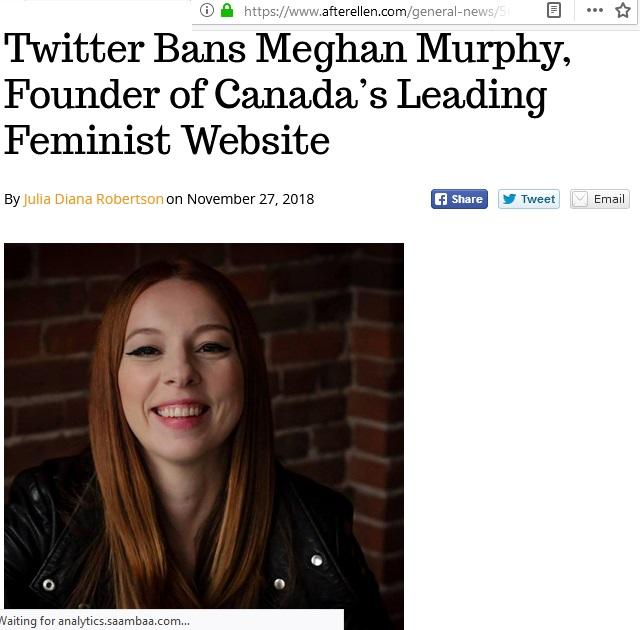
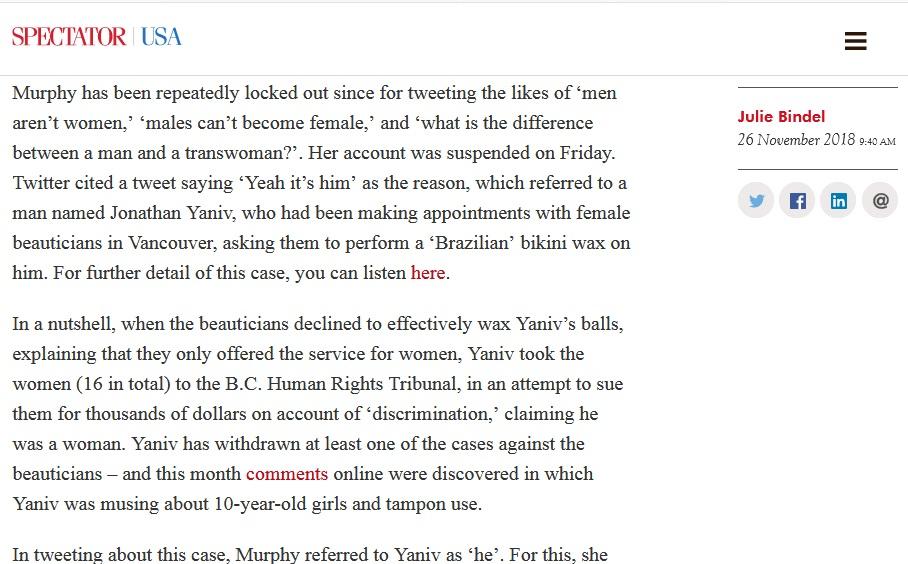
The subpoena and its testicles: understandably some cognitive dissonance is involved in calling the litiginously intruded organs 'hers.' For skeptically resolving the double-take in print, Murphy is now, ironically, permanently suspended.
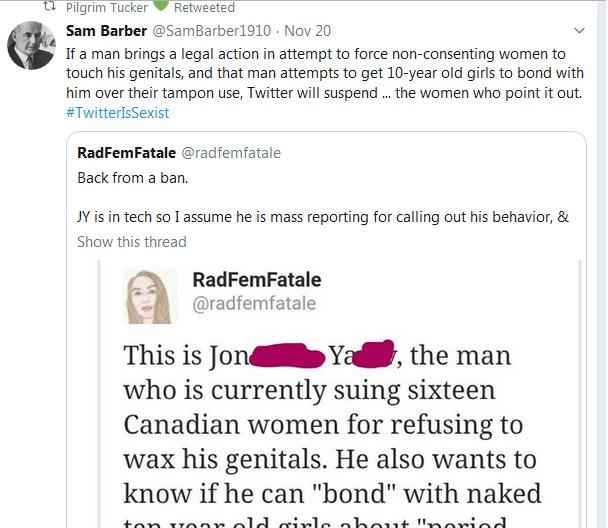
Urwin’s 25 Nov. comment was, “So Twitter bans women for this, but doesn’t ban men who actually threaten women (writing from experience here). Such a classy company.”
This tweet may have endeared Urwin, who has herself shown significant sympathy towards trans people (https://www.standard.co.uk/lifestyle/london-life/jack-monroe-on-coming-out-as-transgender-i-will-always-be-on-the-girls-team-a3109951.html) with the large cadre of radical feminists backing Murphy up in dismissing all transsexual sex-changing ambitions as invalid. When Urwin tweeted out her ‘paedophiles swarming in’ story attached to a vitriolic anti-Twitter message, “My story from today's @thesundaytimes: Twitter, cesspit that it is, is being flooded by paedophile-promoting accounts,” she mostly inspired two types of Twitter activists to respond: anti-transsexual feminists, and youthful gamers who thought it would be fun to fire at deviant accounts. The latter didn’t last long, since their success rate in making kills was much lower than they expected, but the former organized a special initiative headed up by a dedicated account. Beginning as @mcoaliton (presumably for ‘maps coalition’), it suffered at first from its spelling error and changed, after a few days, to @getpedosoffhere. It was soon off to the anti-pedophile races, and, only days in, was already reciting the long-debunked, ridiculously inaccurate statistics from 20th-century psychiatrist Gene Abel (https://justpaste.it/4lfyj) claiming that the average pedophile molested over 100 victims over the course of a lifetime. As always in such efforts, there were many other distortions, cherry-picked horror stories, and scary bits of misinformation.
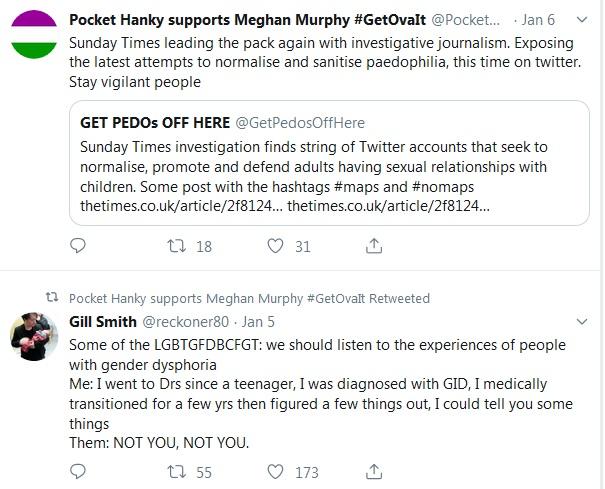
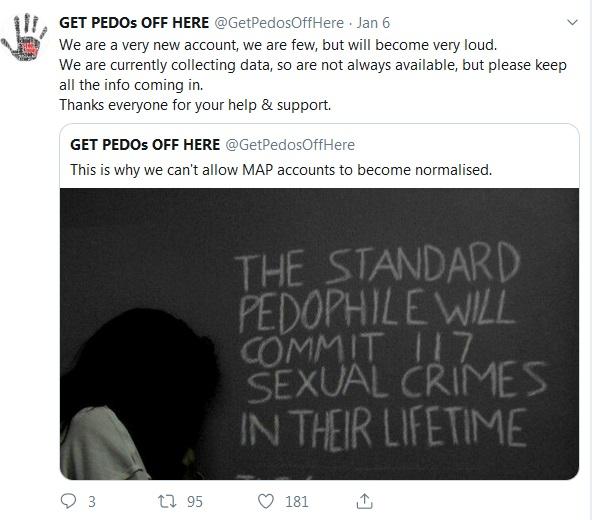
The key to understanding this self-selection of activists is to understand that the brigade sometimes derogatorily called ‘trans-excluding radical feminists,’ or ‘TERFs’ (a much-disliked label, though one prominent account labels itself @little_terfy), tends to regard non-offending pedophiles and male-to-female transsexuals as pretty much the same problem: inherently devious, sexually overcharged people trying to get into safe spaces even though they can’t be trusted.
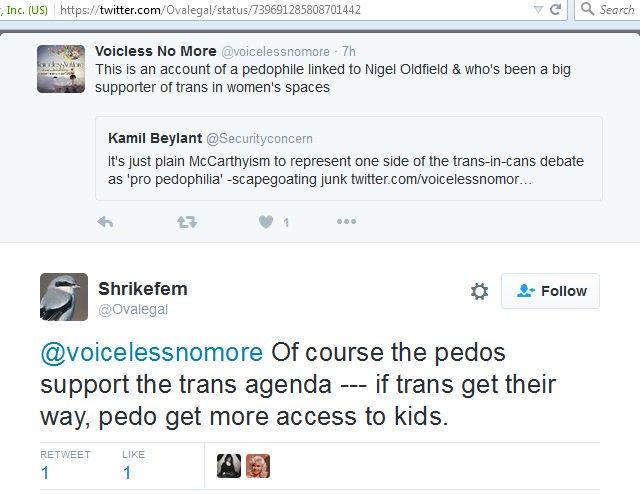
From the anti-transsexual feminist perspective, Twitter is mollycoddling these two insidious groups and making life difficult for real women supporting real women – themselves. The specter of pedophiles proliferating on Twitter offers the feminists an avenue for attacking the website, and with it a world-view that wants to place sinister stubbled faces and dangling, unredacted penises in women’s washrooms all over the world – not to mention hospital wards, rape shelters, and so on.
In the case of male-to-female transsexuals, the nature of the yellow streak that tars them collectively begins with a unique Y – the Y chromosome. But isn’t this, perhaps, a more realistic qualm than some of the group taints that have been attributed to racial, religious and sexual minorities? Men do, after all, account for 80.4% of all violent crime arrests (2011 U.S. statistics https://en.wikipedia.org/wiki/Crime_in_the_United_States), 88.2% of all murder arrests and, unsurprisingly, 98.8% of all rapes. There’s no reliable evidence yet to say how greatly the proportionate statistics may differ for males who have gone into or through transition to female, but, from the TERF viewpoint, the Y streak is still there, regardless, and has not been demonstrably neutralized as a threat.

Let’s pause for a brief, necessary side-excursion about terminology. One thing that makes the acronym ‘TERF’ harsh is that the more liberal feminists at risk of bearing that label state that they don’t exclude transwomen – as long as they present themselves as ‘trans,’ rather than as women, per se. As a way to avoid the TERF acronym in the rest of this article, I’ll use a term that recognizes the group’s stress on the natal body as a biological and political centrality: ‘somatic (= related to the body) essentialist.’ Somatic-essentialist feminists, SEF. This term can suitably include some men of similar views.
Back to the main track. In SEF pronouncements, one often sees sentiments like:
[quote]
But it isn’t about you and your feelings. Nor is it about ‘genitalia.’ It is about risk.” (Harvey Jeni, @GappyTales).
Woman is not a feeling. Woman is biological truth. Stop using intersex people to prop up your idea that people are born in the wrong body. The lady brain theory is absurd. Feelings don’t change reality. (Joanna, @a_womans_woman)
(Television personality Gloria Hunniford, speaking on the ITV network television program Loose Women, about transwomen in hospital women’s wards) said, “’If a man still has his willy and all his tackle, then as far as I am concerned, he/she is a man.” Even if he has his willy and tackle removed, he is still a man – reminder, humans can’t change sex. Ever. Anne Ruzylo @sargesalute
Stop saying “gender.” Every time you see the word, swap it for ‘sex stereotypes.’ Reject the word. It’s doing untold damage…” Jack Appleby @jackappleby
Considering that there’s ZERO evidence that any human, proto-human, non-human primate or even any mammal at all in the past 200 million yrs was born with “innate opposite sex gender identity,” your concern for ‘science’ is a bit quaint. NO-ONE is “trans.” Birdcatcher9 @birdcatcher9
[end quote]
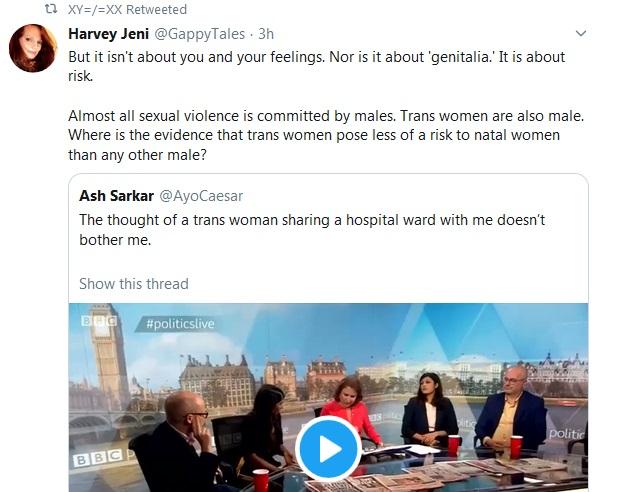
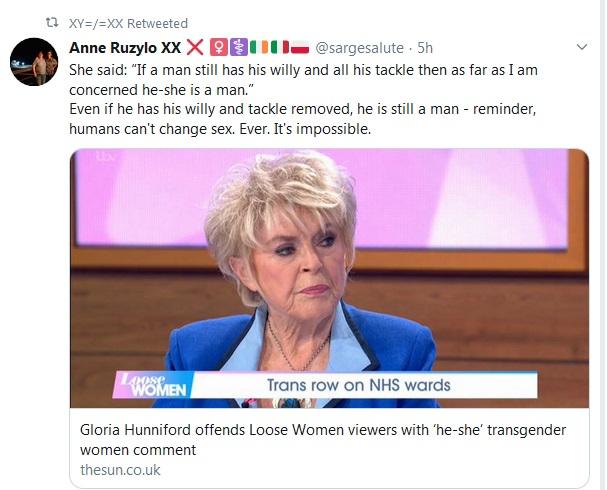
People who are inclined to accept trans people into the sex of their transition presumably aren’t oblivious to the crime statistics about men, nor to the fact that some biological aspects of sex can’t be changed. What leg do they have to stand on to back their supportive attitude up, other than pure, generous compliance with other people’s self-concepts?
First of all, they know that many, though not all, trans people have a long-standing conviction that they intrinsically are the members of the sex that contradicts their body type. It’s by no means clear to what extent any of the typical or stereotypical properties of maleness would be muted or squashed by this profound, life-long identification in a transwoman. Recently, however, researchers managed to get a sufficiently large cohort of gender-nonconforming children together to do quantitative research on some questions. They obtained interesting results – though nothing so far that would directly shed light on any hidden tendencies to become violent or homicidal in the distant future (https://www.theatlantic.com/science/archive/2019/01/young-trans-children-know-who-they-are/580366/).
[quote]
When the 85 gender-nonconforming children first enrolled in (University of Washington psychologist Kristina) Olson’s study, her team administered a series of five tests that asked what toys and clothes they preferred; whether they preferred hanging out with girls or boys; how similar they felt to girls or boys; and which genders they felt they currently were or would be. Together, these markers of identity gave the team a way to quantify each kid’s sense of gender.
The team … found that children who showed stronger gender nonconformity at this point were more likely to socially transition. So, for example, assigned boys who had the most extreme feminine identities were most likely to be living as girls two years later. This link couldn’t be explained by other factors, such as how liberal the children’s parents were. Instead, the children’s gender identity predicted their social transitions.
Charlotte Tate, a psychologist from San Francisco State University, says that this quantitative research supports what she and other transgender scholars have long noted through qualitative work: There really is something distinctive and different about the kids who eventually go on to transition. From interviews with trans people, “one of the most consistent themes is that at some early point, sometimes as early as age 3 to 5, there’s this feeling that the individual is part of another gender group,” Tate says. When told that they’re part of their assigned gender, “they’ll say, ‘No, that’s not right. That doesn’t fit me.’ They have self-knowledge that’s private and that they’re trying to communicate.”
[end quote]
Perhaps always having always experienced oneself as a girl is actually much of the way to being there, even in matters such as affinity for violent behavior. Then, in adolescence, taking hormone therapy minimizing the effects of testosterone, a ‘male hormone’ that is associated in complex ways with aggression (https://en.wikipedia.org/wiki/Testosterone), may add a secondary physical component to the departure from maleness.
Another consideration is that most members of society have now accepted that homosexuality is either a matter of being “born this way” or something tantamount to that – in any case, fixed in the psyche without prior choice. Whatever imposes this sexual orientation effect isn’t purely chromosomal – identical twins may differ. Nonetheless, there are presumably later patch-throughs in neurological development where an indelible pattern can be woven into the basic motivators of the developing brain. None of these factors can be directly visualized yet: there is no distinct brain engram that can be seen on a scanner that says ‘this person is developing a same-sex sexual attraction.’ Yet, clearly, something along those lines must be there, and it doesn’t take much of a leap of faith to wait for the 2052 scientific publication that finally draws a schematic diagram of the cryptic array of neurons involved. Many of the SEFs proudly proclaim themselves as lesbians, without any sense of hypocrisy at attributing themselves a feature that can’t be substantiated in any objective way – other than by listening to credible attestation. If ‘lady brain’ is a myth, where did ‘lesbian brain’ come from, especially when the identical twin sister lacks it? Surely there could equally be a ‘lady brain’ component that becomes wired among the tangles of the transwoman’s neurons at some point during early development. Even if the transwoman’s twin differs. There’s nothing to stop two genetically identical siblings from having different ‘takes’ on who they are in very early, primal identifications that then become hard-wired.
Any perception, however, that the SEFs are on unbearably shaky ground with their biological territoriality is undone by one overwhelmingly important factor: as Harvey Jeni says, above, “it’s about risk.” No matter how much the Y streak is diluted by identification and hormonal management, that drop of native male blood is still a risk. No one knows exactly what it will do. Yes, there are women who will commit any crime you can imagine, and who also have every deviant sexuality you can think of, and then some, but still – in a word: ‘men.’ Let's get real, here. The foreign, as right-wing thinking always insists, is bound to be more alienated than the homogeneous. Men are a risk.
Small but colorful compendia have been made of transgendered offenders who were probably insincere about it, or who committed revolting crimes while transitioning or thereafter. These cases – remember the Karen White Alamo! – (Karen was a serial rapist in England who, in a highly preliminary state of transition – uncut – talked the authorities into a berth in a women’s prison, where ‘she’ then raped additional women https://www.theguardian.com/society/2018/oct/11/karen-white-how-manipulative-and-controlling-offender-attacked-again-transgender-prison) are not known to be more proportionally frequent or more disturbing than those involving actual women.
[Update Jan 20: In response to the above material, my attention was brought to a Swedish study that had examined crime rates specifically of people who had surgically transitioned from male to female or female to male. This material of dubious impact is discussed below in Footnote 1.]
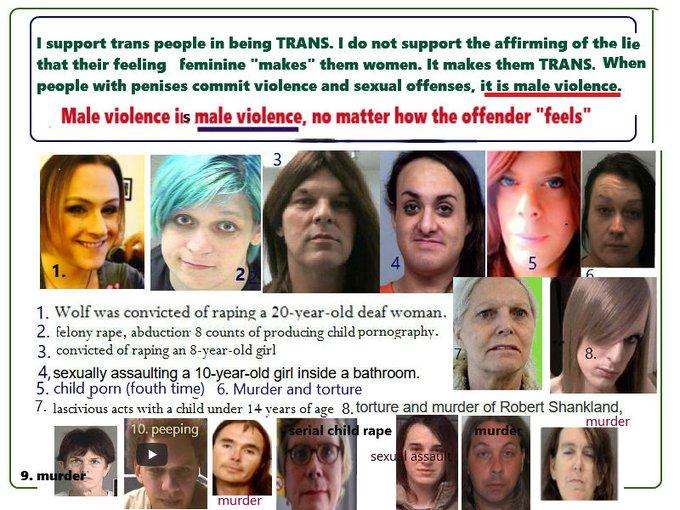
My identity is my nature; yours is your "feelings."
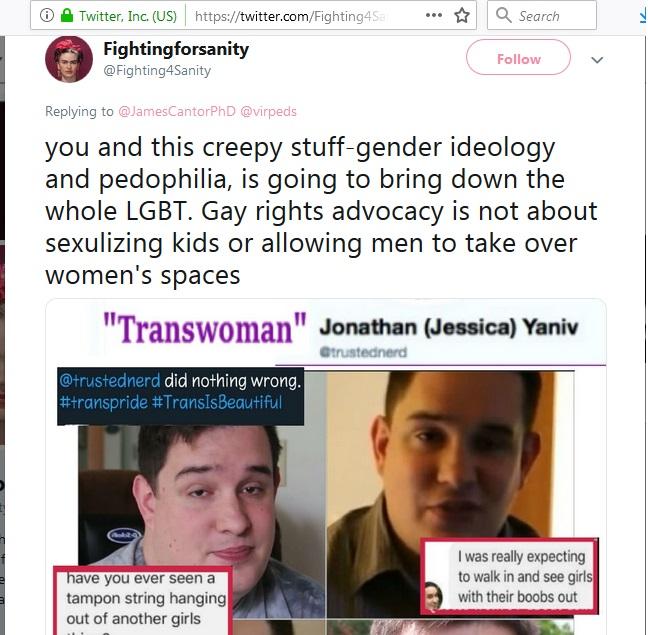
In fact, nothing this reporter has seen recently is more surprising than the actual statistics about prison sexual assaults in the USA (Nancy Wolff and co-authors, https://www.ncbi.nlm.nih.gov/pmc/articles/PMC2438589/ )
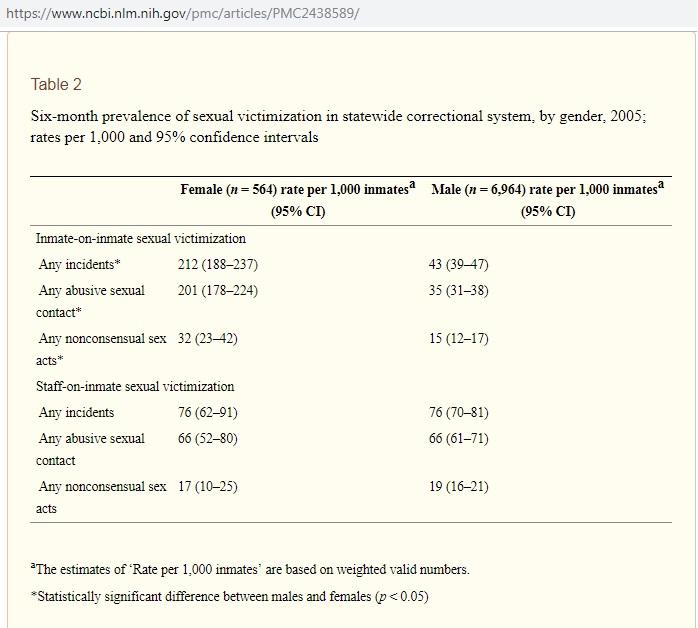
The bottom line is that women were 4 ½ times more likely to be sexually assaulted by another woman inmate in prison than a man was to be similarly assaulted by another man. Moreover, going beyond touches and into ‘nonconsensual sex acts,’ women were twice as likely to experience such assaults from other female prisoners than men were from other males:
[quote]
Prevalence rates (of sexual assault, including unconsented touching of sexual parts – BN) were highest for female inmates, with 21.2% reporting an incident of some type of inmate-on-inmate sexual victimization in the previous 6 months. This rate was four and a half times higher than that estimated for male inmates (4.3%). Incidents of abusive sexual contact contributed most of the difference in inmate-on-inmate prevalence rates by gender. Female inmates were roughly six times more likely to report an incident of abusive sexual contact (i.e., including a sex act, not just a touch – BN) than their male counterparts (20.1 vs. 3.5%), while only being twice as likely to report an incident of a nonconsensual sex act (3.2 vs. 1.5%, respectively). There were no statistically significant differences between males and females in rates of experiencing staff-on-inmate sexual violence. While female inmates were more likely to be sexually victimized by other inmates than by staff (21.2 vs. 7.6%), male inmates were more likely to report an incident of sexual victimization perpetrated by staff (7.6 vs. 4.3%).
[end quote]
Sexual assault by prison staff wasn’t significantly different in incidence for men and women. Journalistic articles about rape in women’s prisons, however, are completely focused on offenses by male staff – as we can see above, a threefold less likely scenario than offenses by co-imprisoned women (https://www.huffingtonpost.com/entry/opinion-brown-me-too-women-prisons_us_5ac28e1de4b00fa46f854abf).
Wolff et al. commented: “While it is customary to attribute violence to men, it may be that the rage that motivates violence and the desire to dominate that motivates rape are traversing the gender divide.” This thought has not hit the cultural mainstream in a big way.
The massive gap between the SEF perception of female potential for sexual violence and the actuality, at least as seen in prisons, is actually typical of risk situations. Dr. Peter Sandman, the author of a risk communication philosophy that became popular in the late 1980s, held that perceived “Risk = Hazard + Outrage” (http://www.psandman.com/index-OM.htm, https://en.wikipedia.org/wiki/Outrage_factor). The perception of risk is weighted not only by the actual hazard involved, but also certain ‘outrage’ factors that generally measure the extent to which people feel out of control of the risk situation. The principal outrage factors are trust, control, voluntariness, dread, and familiarity.
SEF women see other women as familiar and potentially trusted, mostly integrated into the relative control of the bonds of shared womanhood. The transwoman, on the other hand, is exotic in this context, which is always a problem in risk assessment. Most SEF women find it hard to imagine how they could identify deeply as a member of the alternative biological sex, particularly given the many problems perpetrated by the sex in question. Still more exotic is the pedophile, who experiences attraction to – gasp – children. This is so exotic that the outrage factors are automatically set to extreme, even in the case of numerous NOMAPs who have not offended and can give a good account of why they find offending objectionable. Trust is negative, control is assumed to be lost (too exotic; in fact so exotic that ‘they’ probably don’t identify with ‘us’ at all, or they’d be less exotic), voluntariness is minimal (someone could disclose themself as a hitherto concealed pedophile any time, effectively sneaking up), dread is high (the dread factor is amplified by any notion that people choose their sexualities, something we notice tends to be automatically assumed about socially unaccepted deviant sexualities even by those who possess more accepted deviances and see them as purely natural), and familiarity is negligible (the only familiar people who have even met a known pedophile are those who have been sexually abused by one or have been assigned to work with sexual offenders in the corrections or health care industries). In this situation, the tiniest level of actual hazard can still trigger the maximal level of outrage.
My frequent collaborator Kamil Beylant has pointed out that this high intensity outrage over the relatively low risk posed by transwomen and NOMAPs is reminiscent of what happens when American neighborhoods get into wrangles about the extent to which dogs should be allowed off-leash in parks. Most urban dogs are well socialized to be what you might call ‘NOBITES,’ but the chance that one of them, whose owner says they are docile, will nonetheless turn out to secretly be ‘pro-tooth-contact’ can never be completely ruled out. And, over extended times and over broad areas, incidents may occur. When that happens, there’s a chance that a child will be traumatized for life. Can even one such incident be excused? Shouldn’t all dogs be kept on leash at all times? Anyone who has ever attended one of these discussions will have noticed the astonishing level of rage and umbrage that is produced by this topic. In the confrontation between gobsmacked owners whose angelic dog best friends are being called killers, and steaming parents and all-purpose neurotics who are convinced the owners are irresponsible degenerates caring nothing if innocents are savaged, it’s always lucky if actual violence doesn’t break out.
Psychologist James Cantor, one of the leading world authorities on the study of pedophiles, sex offenders and NOMAPs, has tweeted to a challenger:
Dr. James Cantor @JamesCantorPhD Jan 6 Replying to @Kateco
Now take your principle to its logical end: The great, great majority of abusers are men. So, let's remove all men from contact with children. That most of them are entirely innocent doesn't matter. You either treat the innocent like they're guilty or you don't.
The luminous, pragmatic idealism of the last statement – You either treat the innocent like they're guilty or you don't – is the antithesis of all the strategies of the clannishly outrage-prone. People from groups that seem too exotic – too Other – are expendable as far as this criterion goes. The presumption of innocence is earned via familiarity, not just by being there and by claiming to be cooperative and open for supervision.
What difference could it make, that drop of deviant gender or sexuality in their veins, and yet because of it, people would always be on the watch for the expected failure at the critical moment. Everyone knew that you couldn't rely on deviants, sooner or later they would let you down; he knew it too, but now he asked himself whether they didn't fail because failure was expected of them. They were never given a chance, poor devils.
Or maybe they will be given a chance, if the vengeful machinations of Rosamund Urwin and the SEFs don’t get them expelled from society for committing to obey the law.
-- 30 --
FOOTNOTE 1.
Update: In response to publicity about this publication, Twitter user @PocketHanky cited a 2011 study by Cecilia Dhejne and colleagues from the Karolinska Institute, Stockholm, Sweden, in which 191 male-to-female and 133 female-to-male gender-reassigned people were studied for a series of factors that included crime involvement https://journals.plos.org/plosone/article?id=10.1371/journal.pone.0016885
PocketHanky’s interpretation was, “Long term studies into males who transitioned show they retain the same rates of criminality as other males.” In fact, “studies” was an exaggeration, since only one such study exists, but Hanky had accurately paraphrased one line from the study. I’ve put it in boldface in the midst of its surrounding text. Other text of interest will be put in italics.
[quote]
Transsexual individuals were at increased risk of being convicted for any crime or violent crime after sex reassignment (Table 2); this was, however, only significant in the group who underwent sex reassignment before 1989.
Suicide
Comparisons of female-to-males and male-to-females, although hampered by low statistical power and associated wide confidence intervals, suggested mostly similar risks for adverse outcomes (Tables S1 and S2). However, violence against self (suicidal behaviour) and others ([violent] crime) constituted important exceptions. First, male-to-females had significantly increased risks for suicide attempts compared to both female (aHR 9.3; 95% CI 4.4–19.9) and male (aHR 10.4; 95% CI 4.9–22.1) controls.
(“aHR” = “adjusted hazard ratio.” This item measures relative risk in a ‘Cox regression’ statistical test, where a value of 1 indicates sameness between two groups such as female-to-male trans males and approximately matched non-trans male controls. The ‘adjustment’ indicated by the ‘a’ indicates that transpeople were paired with controls with similar histories vis-à-vis immigration and psychiatric medical consultation – BN)
By contrast, female-to-males had significantly increased risk of suicide attempts only compared to male controls (aHR 6.8; 95% CI 2.1–21.6) but not compared to female controls (aHR 1.9; 95% CI 0.7–4.8). This suggests that male-to-females are at higher risk for suicide attempts after sex reassignment, whereas female-to-males maintain a female pattern of suicide attempts after sex reassignment (Tables S1 and S2).
Crime
Second, regarding any crime, male-to-females had a significantly increased risk for crime compared to female controls (aHR 6.6; 95% CI 4.1–10.8) but not compared to males (aHR 0.8; 95% CI 0.5–1.2). This indicates that they retained a male pattern regarding criminality. The same was true regarding violent crime. By contrast, female-to-males had higher crime rates than female controls (aHR 4.1; 95% CI 2.5–6.9) but did not differ from male controls. This indicates a shift to a male pattern regarding criminality and that sex reassignment is coupled to increased crime rate in female-to-males. The same was true regarding violent crime.
[/end quote]
A look at Table S2 shows that the cautionary line that analyses were “hampered by low statistical power and associated wide confidence intervals” was very much a problem in the ‘crime’ section of the study. Low sample numbers and wide confidence intervals are generally a predictor that later and stronger analyses might give completely different results. Crime data were recorded as incidents, namely, convictions, and there were only 8 violent crime convictions involving a transwoman in the study period (red arrow and circle in table). We don’t even know if these convictions involved different people; confidentiality constraints probably blocked publishing further details. In principle, one person could have accounted for all 8 convictions, thus skewing the data into the Gene Abel realm of statistical ludicrousness. We can only trust things weren’t this wonky. The confidence interval for male-to-female violent crime had range of over 50, which, given the numbers involved, is statisticalese for ‘shot in the dark.’
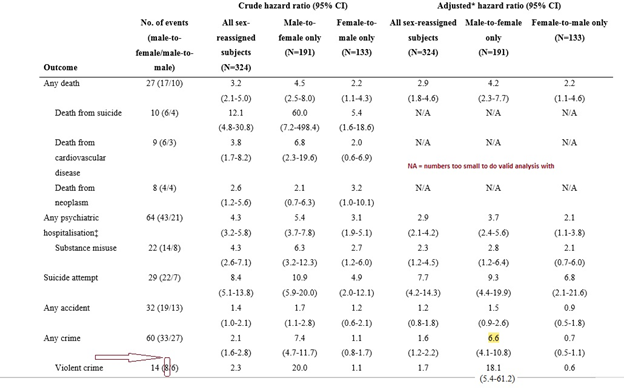
Table S2. Risk of various outcomes in sex-reassigned individuals in Sweden compared to controls matched for birth year and final sex.
As the first paragraph in the quote says, the crime stats for transgenders were only greater than those of non-transgenders for trans people who surgically transitioned before 1989. The younger generation apparently wasn’t implicated; numbers of crimes were too small for a detailed analysis to be done. As another part of the study’s text notes, such findings about the pre-1989 people “might also be explained by improved health care for transsexual persons during 1990s, along with altered societal attitudes towards persons with different gender expressions.” Perhaps the crime rate effect PocketHanky was excited about, even if real, has already effectively disappeared.
The early days of transgender reassignment weren’t the same as the current day, where groups of transgendered university professors are starting to get together. It wasn’t uncommon for early transgenders to be associated with the sex trade, where there was a distinct and vibrant market for females who could satisfy men’s homosexual urges in a way that wasn’t entirely gay. People who were awkwardly intersex for conventional employment could find sustenance there. But, especially where the sex trade was illegal or under a social cloud, there was a tendency for crimes and violence to be associated. We don’t know how many, if any, of the crimes recorded in the study might have been in that framework.
An interesting factor that PocketHanky didn’t mention was that there was an equally odd crime measure for females who had transitioned to male: they had crime statistics that, if you again suspend disbelief about the low numbers involved, were equivalent to those of males. Transgenders of male and female birth origin had similar crime rates. What was that all about? Did testosterone or some other physical aspect of transition increase the volatility of natal women? Were social factors involved that we can only guess at? Or were the women who elected to transition already more violent in nature than those who remained female? That matter was not studied. One aspect that an ordinary urban observer notices among women who transition to male is that many of them at first have lived as lesbians. This raises an issue that PocketHanky would undoubtedly feel very uncomfortable thinking about. We have a cultural impression, possibly a stereotype or possibly somewhat real, that gay men tend to be rather unaggressive, not engaging much in boyhood fisticuffs when young, and often being bullied. Lesbians have a long-standing stereotype, perhaps bearing a grain of reality, of being more aggressive than heterosexual women. Blues singer Ma Rainey’s classic “Prove It On Me Blues” song from 1928 shows the arche/stereotypical ‘bull dagger’ brawling over women at the lesbian bar:
Went out last night, had a great big fight
Everything seemed to go on wrong
I looked up, to my surprise
The gal I was with was gone.
There are no crime statistics that I am aware of that distinguish gay and lesbian from heterosexual perpetrators – nor would I wish there to be. The whole matter of group-specific crime stats is understandably avoided by sensible social psychology, since any statement that a certain racial or other group is more inclined to crime than the majority could immediately redound to make any existing problem worse, with the group becoming less trusted and more alienated as a reaction to the statistics. Nonetheless, in looking at Dhejne et al.’s data, where such stats have been generated and have to be interpreted, we have to confront the possibility, not controlled for in the study design, that the stats for transmen could be contiguous with the stats for the lesbian background they transitioned from. This would then mean that the dreaded elevation of crime statisics for the transwomen was, in fact, even if real, a number that only made transwomen as hazardous as lesbians. Such are the grotesque tangles researchers get into when they try to connect diverse demographic groups to crime statistics.
The crime data of the Dhejne et al. study would need much replication by independent studies if they were to have any credibility as social facts. At the moment, they only stand as preliminary findings based on small numbers. As the chance, however, of any researchers in democratic nations trying to reproduce the same sort of study is extremely small, I can only recommend that they be regarded as a statistical blip of unestablished meaning.
*************************************************
Additional images.
